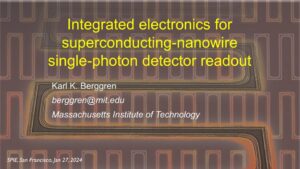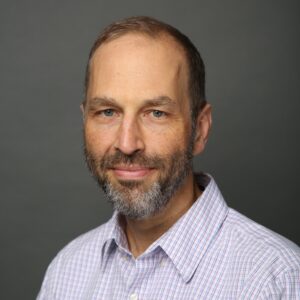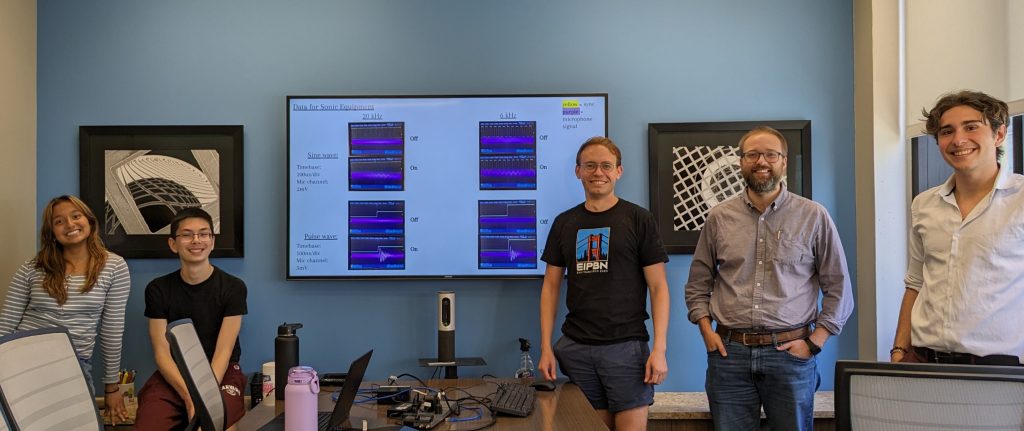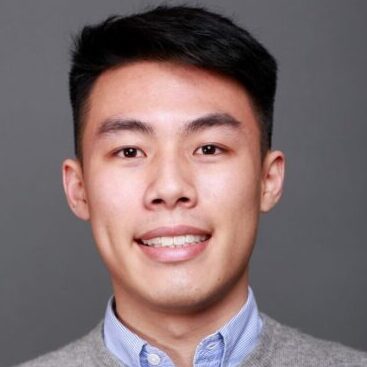News
Prof. Berggren SPIE Presentation Available

Prof. Karl Berggren gave a presentation on Integerated Electronics for Superconducting-nanowire Single-photon Detector Readouts at the SPIE Quantum West conference this January. The recording of this presentation is now available in the SPIE Digital Library. To access the talk, you may need to be on a University or library network.
Abstract
Superconducting single-photon detectors are a key technology for quantum information science, being of particular use for quantum key distribution and photonics-based quantum computing. However, the biasing, readout, and signal processing associated with the detector is typically handled by off-chip conventional semiconductor electronics. Increasingly, this solution is proving problematic: such electronics consume large amounts of power and are cumbersome to integrate on the same chip as the detectors. Superconducting classical electronics relying on Josephson junctions are an alternative, but require an integrated fabrication process, which adds complexity to the device. An alternative is to use the superconducting nanowires themselves, in the form of “cryotrons”, an alternative to Josephson junction superconducting switches first proposed in the 1950s, but recently experiencing renewed interest with scaling to the nanometer length scale. These technologies and applications of them to SNSPD readout and signal processing will be discussed.
The full talk can be found in the SPIE Digital Library here.
Professor Berggren named a 2024 MacVicar Faculty Fellows

Congratulations to Karl for being awarded the MIT MacVicar award for undergraduate teaching!
The full details are available at the MIT News website.
QNN Newsletter – 2023 Wrap Up
QNN Newsletter
Dear QNN Group Members, Alums and Affiliates,
We are excited to share our group newsletter for the last quarter of 2023 with you all. Please read on for highlights of the latest research and goings on within the QNN group.
The last term saw a lot of change. We have welcomed four new group members, and saw the departure of three others. Also, the wider QNN community has grown by two with Marco Colangelo and Stewart Koppell both becoming new fathers. Marco welcomed baby Lorenzo, and Stewart baby Cleo. We are wishing the new parents well!
Best regards,
Karl and Donnie
Comings and Goings
This past semester, we’ve welcomed the following new group members:
- Felix Ritzkowksi, Postdoc
- Valentin Karam, no longer an exchange student, officially a Research Support Associate
- Simon Opsahl, UROP
- Steven Khandeh, UROP
The following members have now left and become alumni group members:
- Marco Zagarella, visiting student returning to Italy
- Stewart Koppell, Post-doc, now at Johns Hopkins in Austin, Texas
- Ashley Lou, UROP
Thesis Presentation
Francesca Incalza, “Effects of helium-ion exposure on superconducting nanowires single photon detectors,” Virtual, Jun. 30, 2023. Presentation Link.
Publications (6/1/23 – 12/31/23)
[1]
L. C. Blackburn, E. Golden, A. Wynn, A. Wagner, and N. Gershenfeld, “Design and Simulation of Phase Synchronizer for Adiabatic Quantum Flux Parametron Circuits,” IEEE Transactions on Applied Superconductivity, vol. 33, no. 5, pp. 1–5, Aug. 2023, doi: 10.1109/TASC.2023.3243186.
[2]
J. S. Luskin et al., “Large active-area superconducting microwire detector array with single-photon sensitivity in the near-infrared,” Applied Physics Letters, vol. 122, no. 24, p. 243506, Jun. 2023, doi: 10.1063/5.0150282.
[3]
J. W. Simonaitis and P. D. Keathley, “Twin experiments reveal twin electron dynamics,” Nat. Phys., pp. 1–2, Jun. 2023, doi: 10.1038/s41567-023-02066-8.
Preprints (6/1/23 – 12/31/23)
[1]
I. Charaev et al., “Single-photon detection using large-scale high-temperature MgB$_2$ sensors at 20 K.” arXiv, Aug. 29, 2023. Accessed: Nov. 06, 2023. [Online]. Available: https://arxiv.org/abs/2308.15228
[2]
A. Chou et al., “Quantum Sensors for High Energy Physics.” arXiv, Nov. 03, 2023. Accessed: Nov. 13, 2023. [Online]. Available: http://arxiv.org/abs/2311.01930
[3]
C. Kim et al., “Wafer-Scale MgB2 Superconducting Devices.” arXiv, Dec. 2023. doi: 10.48550/ARXIV.2305.15190.
[4]
S. Lee et al., “First Detection of 120 GeV Protons with Superconducting Nanowire Detectors.” arXiv, Dec. 20, 2023. Accessed: Jan. 26, 2024. [Online]. Available: http://arxiv.org/abs/2312.13405
[5]
F. Ritzkowsky et al., “Large Area Optical Frequency Detectors for Single-Shot Phase Readout.” arXiv, Jun. 02, 2023. doi: 10.48550/arXiv.2306.01621.
[6]
H. K. Warner et al., “Coherent control of a superconducting qubit using light.” arXiv, Oct. 24, 2023. doi: 10.48550/arXiv.2310.16155.
[7]
M. Yeung, L.-T. Chou, M. Turchetti, S.-H. Chia, K. K. Berggren, and P. D. Keathley, “Lightwave Electronic Harmonic Frequency Mixing.” arXiv, Jul. 27, 2023. doi: 10.48550/arXiv.2307.15145.
Talks (6/1/23 – 12/31/23)
EIPBN 2023
J. Simonaitis, “A Low-Energy Counting Electron Spectrometer Integrated into a Scanning Electron Microscope,” presented at the EIPBN 2023, San Francisco, CA, Jun. 01, 2023.
J. Simonaitis, “Apparatus for studying low energy electron-photon interactions inside a Scanning Electron Microscope,” presented at the EIPBN 2023, San Francisco, CA, Jun. 01, 2023.
IVNC2023
A. R. Bechhofer, S. Nirantar, L. Daniel, K. K. Berggren, and P. D. Keathley, “Circuit Model for Nanoscale Optical Frequency Electronics,” presented at the IVNC2023, Cambridge, MA, Jul. 10, 2023.
J. Simonaitis, “Electron-Photon Interaction is a Scanning Electron Microscope,” presented at the IVNC 2023, Cambridge, MA, Jul. 11, 2023.
EUCAS 2023
Emma Batson, “Electrical Characterization of Micron-Wide Magnesium Diboride Wires for SuSPDs,” presented at the EUCAS 2023, Bologna, Italy, Sep. 04, 2023.
Emma Batson, “Superconducting nanowire devices in novel materials: High critical temperatures and transparent superconductors,” presented at the HTSHFF 2023, Giardini Naxos, Italy, Sep. 13, 2023.
PCTS
K. K. Berggren, “Superconducting-Nanowires for High-Energy Physics and Fundamental Science Applications,” presented at the PCTS: Quantum Probes of Wave-like and Sub-GeV Dark Matter, from Photonics to Quantum Sensing, Princeton, NJ, Oct. 27, 2023.
Prof. Berggren South Korea Engagements
K. K. Berggren, “Superconducting Nanostrip Detectors: From Quantum Communications to Dark-Matter Search,” presented at the LTD20, Daejeon, South Korea, Jul. 25, 2023.
K. K. Berggren, “Why Should Everyone Care About Superconducting Nanowire Single-Photon Detectors?,” Korea Institute of Industrial Technology (KITECH), Ulsan, South Korea, Jul. 28, 2023.
K. K. Berggren, “Detecting Dark Matter with Superconducting Nanowires,” Institute for Basic Sciences, Daejeon, South Korea, Jul. 31, 2023.
K. K. Berggren, “Superconducting Nanostrip Single-Photon Detectors for Quantum-Information,” KAIST, Daejeon, South Korea, Jul. 31, 2023.
To unsubscribe or subscribe email wijtmans@mit.edu.
First QNN High School Interns Hosted through NSF program
The QNN group hosted our first summer High School interns this year due to a grant from the National Science Foundation. By expanding the number of high schoolers with direct experience with ongoing research programs, the NSF hopes to increase the potential pool of future scientists. After working with the local Somerville and Medford High Schools, two students were accepted based on their applications to this paid month-long program.
Marjia Masrura Zasra and Caleb Chang of Medford High School worked with graduate student John Simonaitis and Group leader Dr. Donnie Keathley to create methods and models of observing the levels of liquid nitrogen remaining in the canisters. On the final day of the internship they jointly presented their findings on sound-based liquid sensing. They concluded on a best preliminary design and what the next steps could be. We’re proud of these interns for rising to the challenge of designing and implementing these experiments and fielding questions regarding their work!
 High School Interns Marjia and Caleb with their data, John, Donnie, and Joseph Alongi after their presentation to the QNN group
High School Interns Marjia and Caleb with their data, John, Donnie, and Joseph Alongi after their presentation to the QNN group
This program will be offered again in Summer 2024 and information on the program timeline and applications will be distributed through Somerville and Medford High School.
This paid internship was supported by National Science Foundation grant “NSF Quantum Coherent Interactions” under contract No. 2110535
Matthew Yeung awarded the Mathworks Fellowship

Matthew Yeung is a PhD candidate whose research explores interactions between light and nanostructures for both fundamental research and the development of novel optoelectronic technologies. The focus of his current work, which will be supported by this MathWorks Fellowship, is the development of nanostructured devices that can interact with and measure light fields with sub-femtosecond resolution. These devices enable a critical new tool in visible to near-infrared optical metrology: a sampling oscilloscope for light waves, which could offer a fresh time-domain perspective on how light interacts with materials. Matthew’s work has large number of potential applications, including the creation of more efficient solar cells, understanding the fundamental energy transfer mechanisms that enable photosynthesis, and characterizing materials with unprecedented sensitivity. MATLAB has been vital in Matthew’s device design, experiment development, and instrumentation interfacing, and he looks forward to sharing the resulting tools with the MathWorks community. His work has the potential to help usher in revolutionary advances in light-based technologies.